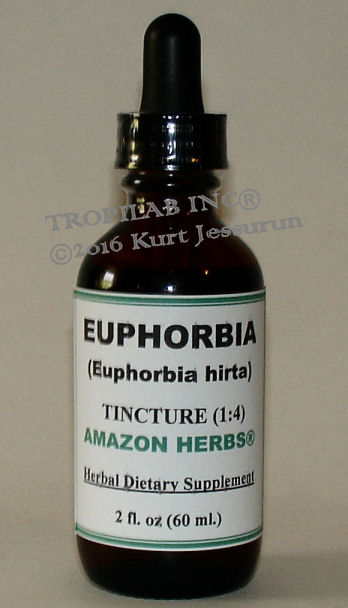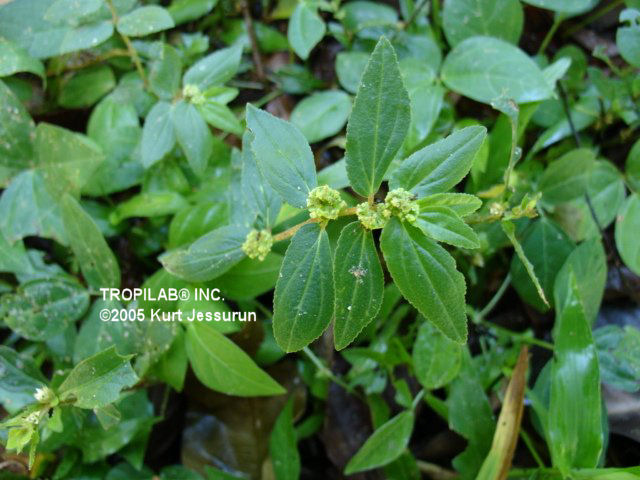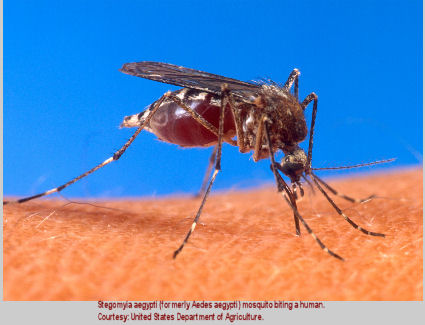 |
 |
|
ASTHMA WEED TINCTURE (tinctura EUPHORBIA HIRTA) from AMAZON HERBS® |
Overview

Asthma weed (Euphorbia) has traditionally been used to manage bronchial asthma, other respiratory tract conditions and laryngeal (throat) spasm. Although in modern herbalism it is more used as a remedy for intestinal amoebic dysentery (Amebiasis). Another application is also the management of syphilis (venereal infection). Euphorbia hirta is locally used in Africa and Australia to manage numerous diseases, including hypertension and edema. It is also regarded as an adequate natural medication for diarrhea, ulcers and as a remedy for acute enteritis (inflammation of the small intestine). Constituents Flavonoids (quecitrin, quercetol), terpenoids, coumarins, tannins, cardiac glycosides, triterpenes (phytosterols), Diterpenes (phorbol esters); alkenes, phenolic acids, shikimic acids, choline. Pharmacology  The aqueous stem and leaf extracts of Euphorbia hirta have potent molluscicidal
activity (pesticides against mollosks).
The aqueous stem and leaf extracts of Euphorbia hirta have potent molluscicidal
activity (pesticides against mollosks).It is a common medicinal plant of India, which is used in a variety of diseases i.e. cough, asthma, colic, dysentery and genito-urinary diseases. The anti-diarrheic activity of the Euphorbia hirta whole plant was investigated. The lyophilized decoction demonstrated anti-diarrheic activity in experimental models of diarrhea induced by castor oil, arachidonic acid, and prostaglandin E2. A flavonoid, quercitrin, with antidiarrheic activity, was isolated from this crude drug. A study suggests that the active component(s) in the water extract of E. hirta leaf had a similar diuretic spectrum to that of Acetazolamide (used to inhibit and reduce the symptoms of altitude sickness). These results validate the traditional use of E. hirta as a diuretic agent by the Swahilis and Sukumas in Africa. Euphorbia hirta extract demonstrated active against dysenteric epidemia in 53 patients (Ridet and Chartol). Clinical trials conducted on 150 cases of colopathies related to Entamoeba histolytica with Euphorbia hirta extract. The authors obtained 83.34% of healing. The excellent activity of the plant extract was comparable to pharmaceutical product Flagentyl (an antibiotic) in the management of intestinal amoebas (Martin et al). Euphorbia hirta possesses also excellent hepatoprotective activity, comparable to the drug Silymarin. This prescription drug is used in the prevention and treatment of chronic liver diseases and primary liver cancer. Applications Asthma weed An excellent natural medicine used to manage asthma and bronchial infection, cough and throat spasms. It breaks up mucus and relaxes spasms. It is extensively used as a remedy for liver problems. Dengue and Chikungunya  Asthma weed is used with success to increase low blood platelets count in Dengue fever
and Chikungunya.
Asthma weed is used with success to increase low blood platelets count in Dengue fever
and Chikungunya.Low platelet count, means that the blood possesses too few thrombocytes or specialized blood cells called platelets that help to aid in blood clotting. Dengue is caused by the Aedes aegypti mosquito. It is characterized by fever rash, joint pain and muscle pains. Symptoms can range from mild to severe (life-threatening). The Chikungunya disease is transmitted in the same way as dengue fever to humans by the virus- carrying Aedes mosquitoes. The common symptoms of this virus infection are fever and severe joint pain. Other symptoms may include headache, muscle pain, joint swelling or rash. Natural ways to manage these diseases are with dietary herbal supplements (medicinal tea or herbal tincture) of plants that increase the dwindling platelet count of the blood (Thrombocytopenia), without notable effects in red blood cell and white blood cell counts. For more information on Asthma weed, go to the "MEDICINE FROM NATURE" page. Tincture & infusion Dosage tincture 1 - 2 ml (30 - 60 drops), 3 - 4 times a day Dosage infusion (herbal tea) 1 full tsp per cup; steep in hot water for 10 minutes, 3 - 4 times a day. Precaution & Contraindications There are no known interactions with other drugs. Do no use when pregnant. Reference A Modern Herbal. by Grieve. (Penguin 1984 ISBN#0-14-046-440-9) Not so modern (1930's?) but lots of information, mainly temperate plants. Flora of Japan. (English translation) by Ohwi. G. (Smithsonian Institution 1965 ISBN#-) The standard work. Brilliant, but not for the casual reader. Alterrnative Enterprises for Agriculture in the UK. by Carruthers. S. P. (Editor) (Centre for Agricultural Strategy, Univ. of Reading 1986 ISBN#0704909820) Some suggested alternative commercial crops for Britain. Readable. Produced by a University study group. Plants for Human Consumption. by Kunkel. G. (Koeltz Scientific Books 1984 ISBN#3874292169) An excellent book for the dedicated. A comprehensive listing of latin names with a brief list of edible parts. [179] Famine Foods of the Chiu-Huang Pen-ts'ao. by Reid. B. E. (Taipei. Southern Materials Centre 1977 ISBN#-) A translation of an ancient Chinese book on edible wild foods. Fascinating. The New RHS Dictionary of Gardening. 1992. by Huxley. A. (MacMillan Press 1992 ISBN#0-333-47494-5) Excellent and very comprehensive, though it contains a number of silly mistakes. Readable yet also very detailed. Medicinal Plants of China by Duke. J. A. and Ayensu. E. S. (Reference Publications, Inc. 1985 ISBN#0-917256-20-4) Details of over 1,200 medicinal plants of China and brief details of their uses. Often includes an analysis, or at least a list of constituents. Heavy going if you are not into the subject. Perennial Garden Plants by Thomas. G. S. (J. M. Dent & Sons, London. 1990 ISBN#0 460 86048 8) A concise guide to a wide range of perennials. Lots of cultivation guides, very little on plant uses. Encyclopaedia of Herbs and their Uses. by Bown. D. (Dorling Kindersley, London. 1995 ISBN#0-7513-020-31) A very well presented and informative book on herbs from around the globe. Plenty in it for both the casual reader and the serious student. Just one main quibble is the silly way of having two separate entries for each plant. Glossary of Indian Medicinal Plants (Including the Supplement). by Chopra. R. N., Nayar. S. L. and Chopra. I. C. (Council of Scientific and Industrial Research, New 1986 ISBN#-) Very terse details of medicinal uses of plants with a wide range of references and details of research into the plants chemistry. Not for the casual reader. The Encyclopedia of Medicinal Plants by Chevallier. A. (Dorling Kindersley. London 1996 ISBN#9-780751-303148) An excellent guide to over 500 of the more well known medicinal herbs from around the world. Antidiarrhoeic activity of Euphorbia hirta extract and isolation of an active flavonoid constituent. Galvez J, Zarzuelo A, Crespo ME, Lorente MD, Ocete MA, Jimenez J. Departamento de Farmacologia, Facultad de Farmacia, Universidad de Granada, Spain. The above presentation is for informational and educational purposes only. It is based on scientific studies (human, animal, or in vitro), clinical experience, or traditional usage. For many of the conditions discussed, treatment with prescribed (RX) or over - the - counter medication (OTC) is also available. Consult your doctor, practitioner, and/or pharmacist for any health problem and before using dietary supplements or before making any changes in prescribed medications. |
For the right freight rate, shipping charges, conditions and delivery service, please visit our Webstore page! |
|
TROPILAB® INC copyright disclaimer |